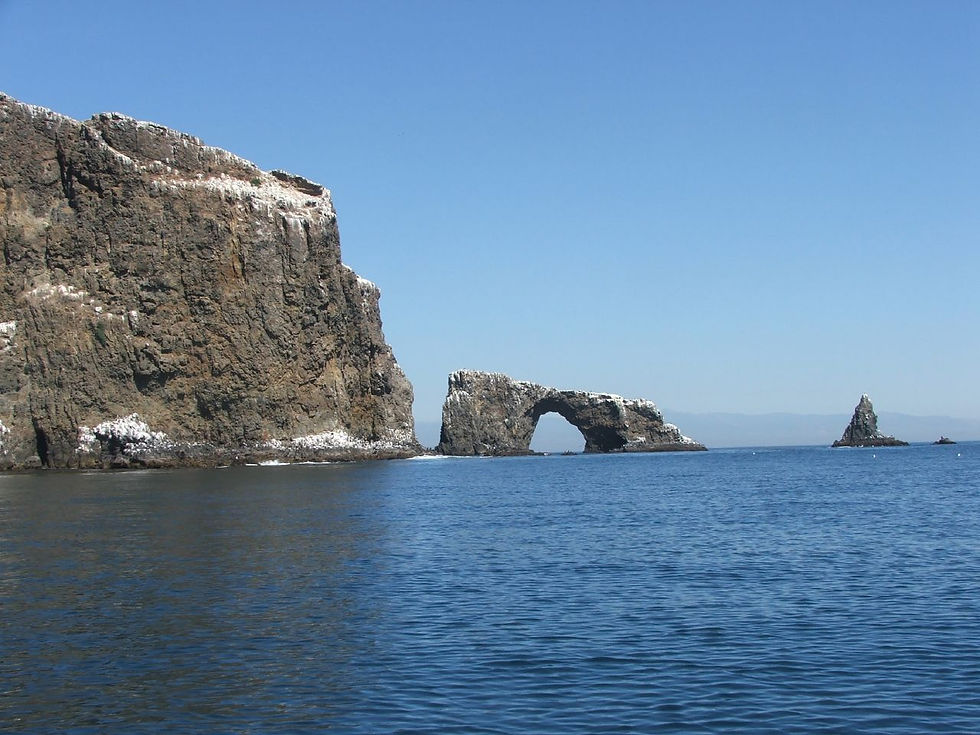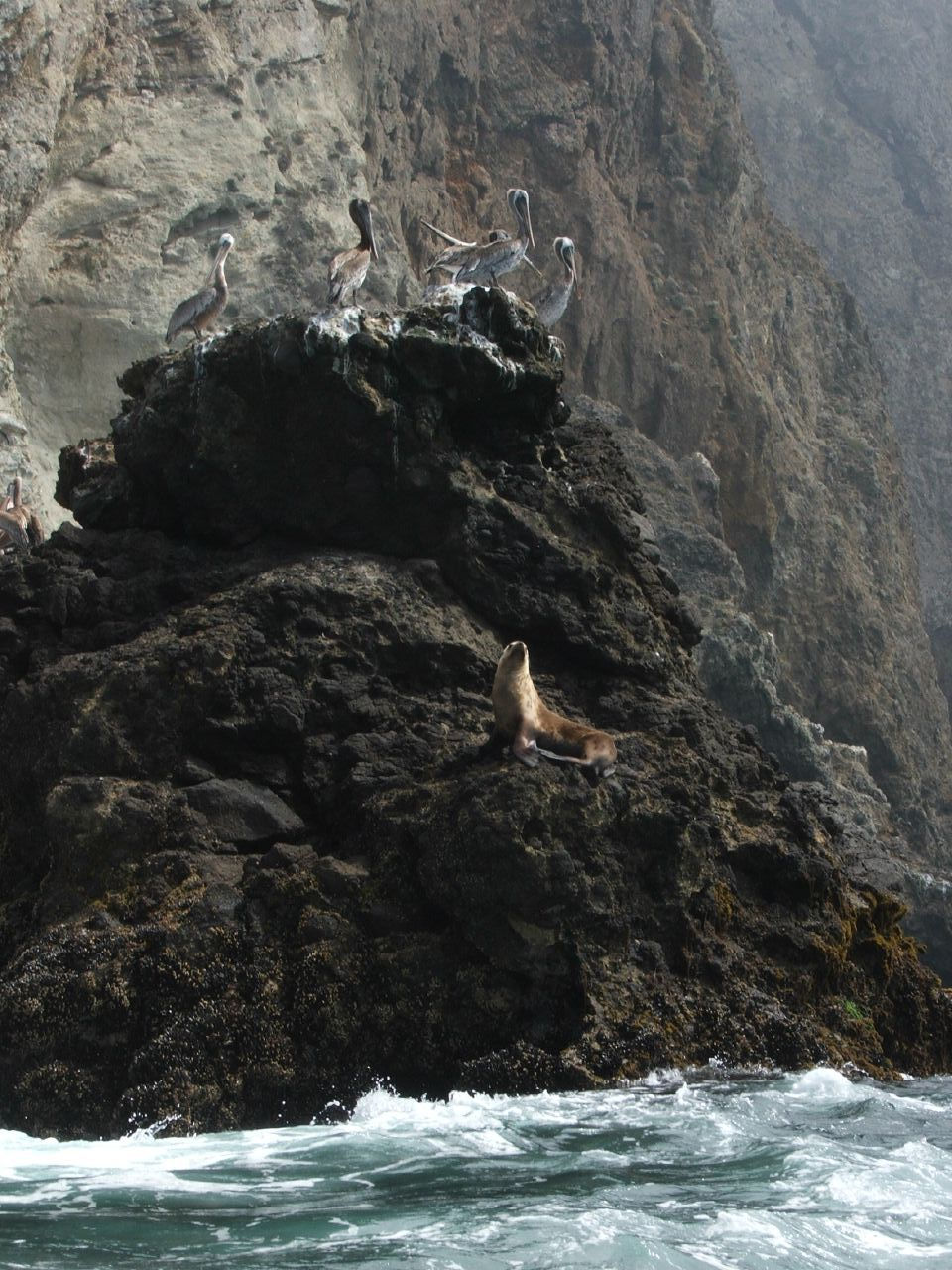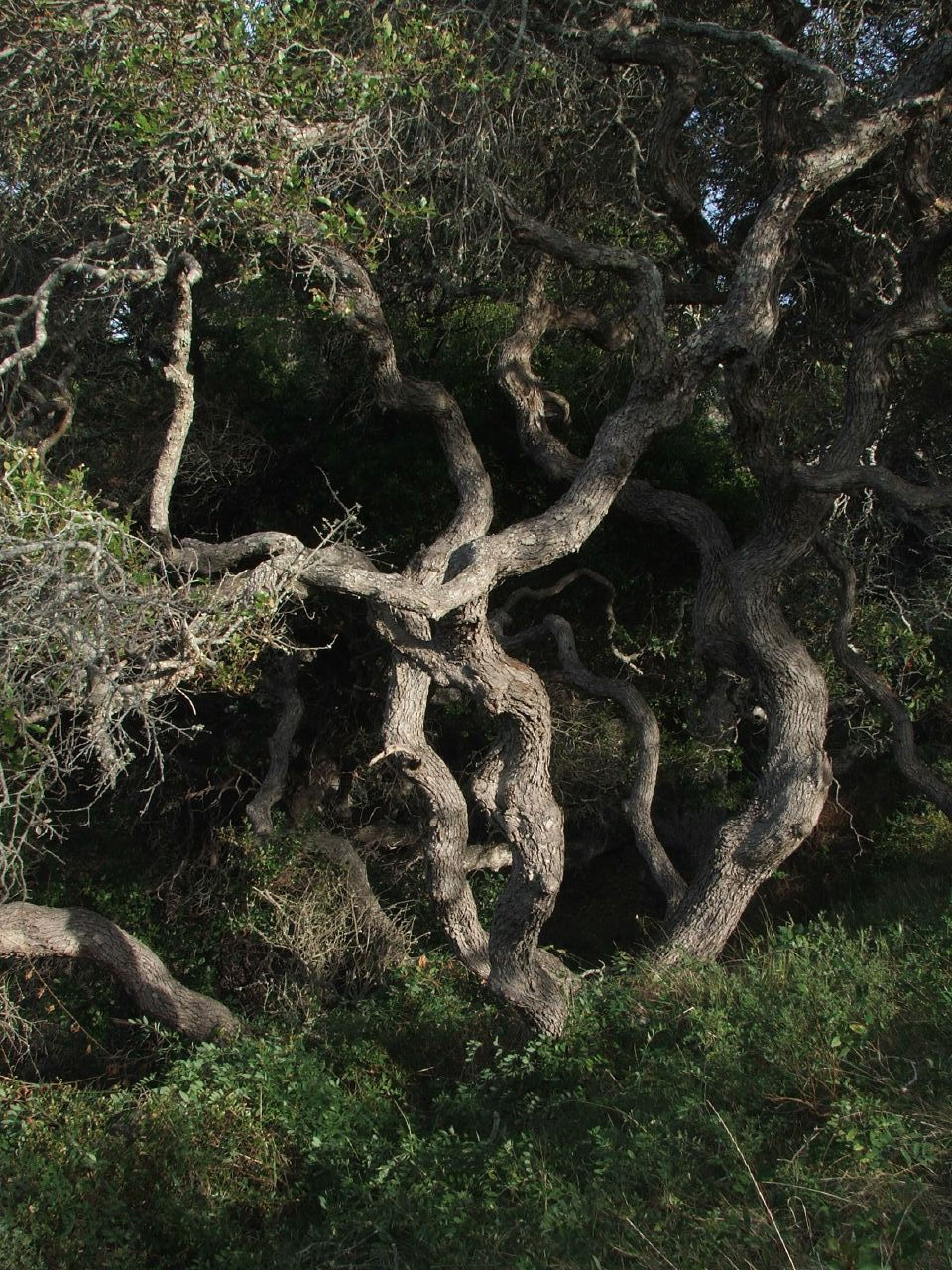My Commute to Work in North America's Galapagos
- Ryan Dibala

- Jul 1, 2007
- 8 min read
Updated: Nov 10, 2022
It was a Monday evening down on Harbor Boulevard and the day’s haze still hadn’t quite burned off. I was greeted at the train station – a heap of stones beside an open, empty parking lot – by Donovan, one of the Institute for Wildlife Studies’ new fox technicians. Being young, cool-headed, and excited about many things in life, Donovan's demeanor was quite agreeable and I was able to mesh exceptionally well with the new addition to our working team. We shared many of the same interests and some of them, like our agreement to split the cost of a hotel room at the local Motel 6, were timely and convenient.
Donovan’s willingness to pick me up at the station relieved me from the bi-weekly burden of toting my bags three miles across town to the hotel. That night, we picked up our groceries at the local Vons grocery store and spent the remainder of the evening in conversation about all things wild. After all, we were budding wildlife biologists, ready to make another commute to what some call the Galapagos Islands of North America: Channel Islands National Park.

Boats moored in the Ventura harbor, where the Park Service boat departed twice a week for the Santa Cruz Island
The morning came in through the window and the ringing of my alarm sprung me out of bed. My head hurt and my throat was dry. We gathered up our gear and headed out to the harbor where the National Park Service boat swayed in the calm morning water. Our heavy bags, loaded with warm clothes, food, and field gear, were placed into an open duffel bag that had been tethered to the head of a crane. It was a Tuesday morning ritual to load our luggage into these heavy-duty burlap sacs and watch a Park Service employee use the crane to perilously swing bags into their on-board positions. I greeted the day’s crane operator, Earl, with a nod of the head and an indecipherable morning grunt. Earl was the classic Park Service maintenance worker: late sixties and built like a tank with bushy gray eyebrows and a neck made of alligator hide. He had big calloused hands that told the story of a thousand mechanical toils and he was never seen without his NPS gray/green baseball cap.

Channel Islands National Park is comprised of five islands, Anacapa, Santa Cruz, Santa Rosa, San Miguel, and Santa Barbara Islands. San Nicolas and San Clemente are owned and operated by the United States Navy, while about 88% of Santa Catalina is owned by the Nature Conservancy (Image: Google Earth)
There always seemed to be little talking on these mornings back to work. No one felt the need to strike up any kind of substantial conversation on the dock. I was content with that. If there was a query or two, it was usually about one’s whereabouts or activities the prior week; however, there were moments when new, undomesticated stories were shared as the boat pushed offshore into the whitecaps towards the four rocky islands strung across the Pacific.

Anacapa Island is the first island one encounters when heading west from the mainland. The island is comprised of three islets. The west islet is home to the largest breeding colony of endangered California brown pelicans (Pelecanus occidentalis californicus) and all of the islets host the largest breeding colony of western gulls (Larus occidentalis) in the world (Photo: Spring Images/Alamy)

The forty-foot tall Arch Rock is found at the eastern tip of Anacapa Island. The island is volcanic in origin, and the beaches of Anacapa are known for their black sand. The volcanic basalt has been eroded by waves in many places, forming arches, stacks, sea caves, surge channels, and blowholes
I had mentioned to Donovan that I had been eagerly anticipating reuniting with our head boss while on the island. I had spent a good amount of time with the Institute for Wildlife Studies' (IWS) founder Dave Garcelon the previous season when he joined us on Catalina to help with the fostering of the eaglets. Spending time with Dave was not only enlightening and thought provoking, but also motivational. It was never a surprise to me that I would end up talking to Dave for hours when he was present; he was a a fascinating man who fervently conveyed his enthusiasm for wildlife biology.

The northern side of Santa Cruz Island is rugged and dramatic. The National Park Service owns 24 percent of the island, while the Nature Conservancy owns the remaining 76 percent

California brown pelicans (Pelecanus occidentalis californicus) and California sea lions (Zalophus californianus) are two of the most common animals using the rocky shoals near Prisoner's Harbor on Santa Cruz Island
This time, Dave had come to the island to assess the health of the newly born captive island fox pups (Urocyon littoralis). Indeed, his eyes lit up when he spoke of the miniature gray puppies and he loved to repeat the story of what he found when he lifted up the lid on two of the den boxes: a third, hidden fuzz ball, all bright-eyed and bushy-tailed. There it sat, helpless as an orphan, its sensitive black eyes innocently staring up at the strange human faces around it and squinting at the harsh light of day.

Three new arrival Santa Cruz Island fox pups (Urocyon littoralis santacruzae). In 2004, the Institute for Wildlife Studies (IWS) began breeding the foxes in captivity and releasing them to the wild to aid in their recovery. The foxes were vulnerable to mainland pathogens and low genetic diversity. In the mid-90s, biologists began to notice a sharp decline in the number of foxes on three of the six island fox subspecies (San Miguel, Santa Rosa, and Santa Cruz). They attributed this decline to increased predation by Golden Eagles (Aquila chrysaetos) that had colonized the islands when fish-eating bald eagles (Haliaeetus leucocephalus) disappeared during the time of widespread DDT use. Concomitantly, Park Service biologists captured and relocated a total of 44 golden eagles to the mainland. With bald eagles returning to the northern Channel Islands, their presence has prevented golden eagles from returning. In turn, the fox population has now recovered fully. In 2016, they were officially taken off the endangered species list
When Donovan and I stepped off the boat at Prisoner’s Harbor on Santa Cruz Island we hopped into our respective trucks and drove up the sinuous dirt road to our quarters at the Navy Site. The air was dry as a bone, filled with billowing dust from our trucks. We rattled through endless fields of fennel (Foeniculum vulgare). Fennel is an invasive weed that was first introduced by settlers in the mid-1800s. Its flavorful aroma strongly resembles licorice and the root can be boiled and eaten directly or used as an Italian spice. The weed most likely rapidly established itself because of the presence of non-native animals. The introduction of domestic goats and pigs resulted in the unexpected decimation of many populations of native plants, which opened up vast areas of land for fennel to explosively colonize. In fact, fennel is so incredibly dominant on the eastern portion of the island that this region actually feels desolate and ugly, as if a fire had ripped through the hills, leaving behind only gray, brittle skeletons.

The eastern side of Santa Cruz Island looking west towards Anacapa Island. Notice the barren landscape. A lot of this is due to non-native species like fennel and feral pigs
One of Santa Cruz’s most redeeming factors is its diversity of habitats. Just when I feel I have gotten an overall appreciation for the island, I stumble upon a fantastic new world. Walking westward, the monotonous, gray fields of fennel fall away behind me, yielding to the dark green canopies of Santa Cruz Island pines (Pinus remorata). Nearer the sound of crashing waves, the pines give way to windblown coastal bluff scrub, a habitat that harbors a multitude of resilient plants and animals. In other areas, I walk along grassy hillsides where, within the undulating hills, nothing can be seen but wild oat (Avena fatua), Italian rye (Lolium multiflorum), and foxtail (Hordeum murinum). I should not neglect to mention the desert maritime scrub habitats that can more commonly be found on the southern islands of San Clemente, San Nicholas, and Santa Catalina, but bands of coastal cholla (Cylindropuntia prolifera), coastal prickly pear (Opuntia littoralis), and tall prickly pear (Opuntia oricola) can be encountered in distinct patches of the island. I once got a little too close to the knobby arms of the cholla and learned from first hand experience why people call these plants jumping cholla. It seems as if one gets even within an inch of the almost caustic succulent, its spines will jump off the cactus and bury themselves deep into one’s flesh. When a cholla spine is dislodged from the skin, it is not just the spine that comes away, but the surrounding flesh as well. To say that being stabbed by a cholla spine is unpleasant would be an understatement.

Santa Cruz Island pine (Pinus remorata) is much like the more widespread bishop pine (Pinus muricata), differing only in its cones that extend straight out from the stem, not reflexed. These pines occur in areas with significant fog, impoverished soils, and relatively frequent fires

Many southwesterly-facing slopes support grassland communities similar to the Mediterranean areas of Europe. Most of these species were introduced to the island via the feed, fur, and dung of livestock

The coastal cholla (Cylindropuntia prolifera) has a striking wine-colored flower that is among the most beautiful of all the species in California. It has cylindrical joints that can easily break off and get lodged in clothing or skin
Once out of the desert scrub, I find myself halted to a dead stop amidst the coastal sage scrub, a habitat that is named after its most conspicuous component: California sage (Artemesia californica). This is likely the most dominant plant community over much of the island. Other plants in this habitat include coyote brush (Baccharis pilularis) and California enselia or brittlebush (Encelia californica). Coastal sage scrub grows in thick, unnavigable patches along south-facing slopes on the island. I have gotten caught in a few areas where a machete would have been useful.
A categorical breakdown of Santa Cruz’s ecological communities would be rather long-winded, so I will limit this description to just one more habitat. As I made my way down a hill into one of this island’s many canyons, I was reminded that Santa Cruz contains more fresh water than any of the other Channel Islands. Exploring these riparian areas offers anything from a trickle of water to a rushing torrent, depending on the time of year one is there. Stepping among the rocks, I might look down and spot a Pacific tree frog (Hyla regilla) that has quieted itself upon sensing my thunderous intrusion. Ferns abound under the elongated trunk-like arms of coast live oaks (Quercus agrifolia) and Santa Cruz Island ironwoods (Lyonothamnus floribundus ssp. aspleniifolius); orange bush monkey flower (Mimulus longiflorus) sparkles in filtered sunlight and a tiny Santa Cruz island fox (Urocyon littoralis santacruzae) eloquently prances atop fallen leaves. Meanwhile, the tinkling of water calms my nerves, and I think that if all of eternity could be wrapped up in one place, this would be it: an ineffable sublimity closely resembling heaven.

Coast live oaks (Quercus agrifolia) create biodiverse savannah in canyons and areas that receive more precipitation from fog

A Santa Cruz island fox (Urocyon littoralis santacruzae) stops to pose for a photo. These canids are not camera shy. In fact, it is thought they were once domesticated by the native Chumash people who inhabited the island
Donovan and I climbed to the top of a hill where the Navy Site sat in incongruity with the land surrounding it. It was a 25-minute trip through dust and fennel from the dock to the dorms and we had arrived with rejuvenated spirits after our periodic five day break. We were ready to start another eight days of fieldwork, Donovan tracking foxes, and me monitoring eagles. I was excited to lace up my boots and set off into the untamed sanctuary of richness – that living laboratory that was so forever changing that every time I set eyes on it, it looked a little different.




Comments